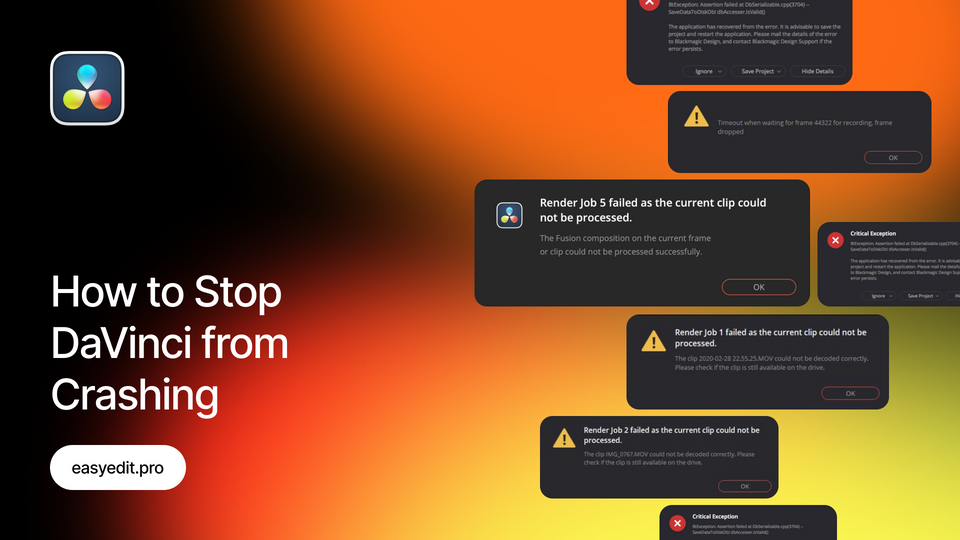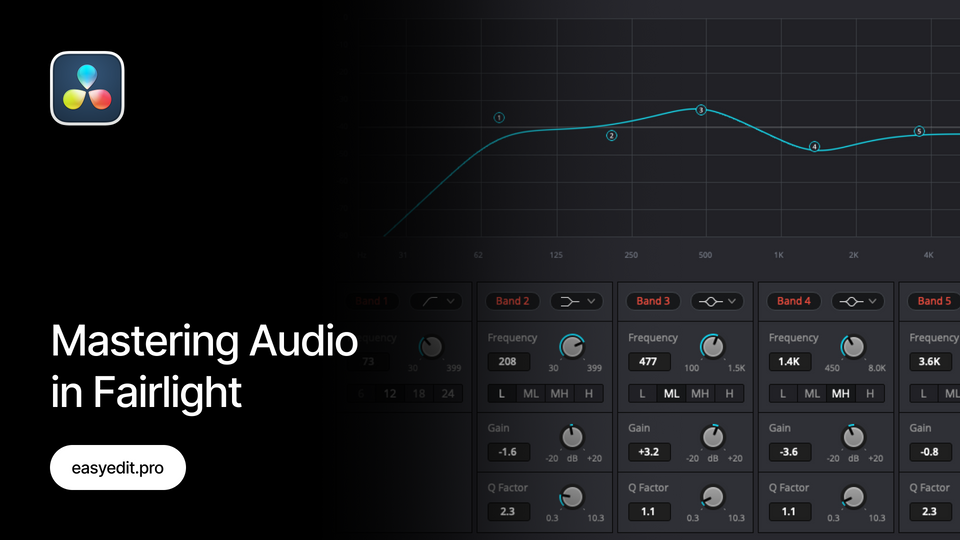
Created: 3 years ago
How to Make Davinci Resolve Run Faster | Optimize DaVinci Resolve
DaVinci Resolve Requirements
Before covering tips to speed up DaVinci Resolve, we should mention the minimum and optimal requirements for this software. The stronger computer and graphics card you have, the faster performance you’ll get from DaVinci Resolve.
Minimum:
GPU: 2GB VRAM
CPU: 6 cores HD / Intel core i5-i7
SSD: 256GB SSD, 512GB Media Drive
Optimal:
GPU: 4-8GB VRAM
CPU: 6-8 cores HD / Intel core i7-i9
SSD: 512GB SSD, 1TB Media Drive, 512GB Cache Drive
Additionally, you need to keep in mind that DaVinci Resolve possibly gives weaker performance if your software is not updated. The latest version of the software would contain not just new features, but also fixed bugs.
Timeline Proxy Mode
If the playback speed of your video is slow, you may quickly fix it by changing the Timeline Proxy Mode.
Here you can lower the playback resolution to Half Resolution or Quarter Resolution. Go to the Playback>Timeline Proxy Mode and select the suitable option:
You can experience with both to compare the result. The video quality may drop, but the playback speed will increase. It may be especially convenient, if you film and edit your videos in 4K or higher, while your computer isn’t strong enough to handle high GPU Acceleration.
You can apply Half or Quarter Resolution to your project while editing and it won’t affect the final render - the result will only depend on your export settings.
To find out more about the best export settings in DaVinci Resolve, you can check this guide.
Playback Settings
To improve the playback speed, you can also go to the Playback Settings and click on Hide UI Overlays and Minimize interface updates during playback:
These checks will hide onscreen controls and UI updates while you work with the footage. You can further try to optimize the performance by switching the Performance Mode to Automatic, Manual, or Disable it.
Automatic mode optimizes Decode Quality, Sizing and Image Processing by default, while the Manual mode allows to separately apply Optimized Decode Quality, Optimized Sizing or Optimized Image Processing.
Optimized/Proxy Media
Another way to speed up DaVinci Resolve is to use Proxy Media clips while editing. This option might be one of the most effective and time-saving and most definitely will help you to work faster.
Go to Media Pool and select the clips that you want to turn into Proxies. Right-click and select Generate Optimized Media or Generate Proxy Media to generate low res copies of your clips for editing purposes:
Go to the Playback menu and make sure you put a check on Use Optimized/Proxy Media if available:
It won’t affect the original clips - when you’ll start rendering your project, the edits you apply on the proxy copies will be automatically applied to the original clips.
Additionally, you can change the resolution of the Proxy Media files in Project Settings. To apply the changes, go to Project Settings>Master Settings>Optimized Media and Render Cache>Proxy Media Resolution and select the suitable setting.
Adjustment Clip
Sometimes DaVinci Resolve can start lagging while you apply Nodes and multiple effects on your footage. Especially it can happen with the effects from Fusion Tab, as they load the graphics card and computer.
One of the ways to speed up the editing process is to apply all Color Grading via one particular layer - an Adjustment Clip. It will allow you to turn off the effects while not working with them.
To create an Adjustment Clip, go to Effects>Adjustment Clip and drag it on top of other layers on your timeline:
With an Adjustment Clip selected, you can go to the Color Tab and apply the effects:
Once you get back to Edit Tab, you can click Disable Video Track for your Adjustment Clip and focus on other tasks. It will reduce the GPU load and save DaVinci Resolve from lagging:
Additionally, you can use this icon to turn off/on all effects:
Render Cache
Also, you can change the Render Cache settings in DaVinci Resolve. Go to Playback>Render Cache and apply Smart or User mode and compare the playback speed to get the best result:
With this setting applied, DaVinci Resolve will cache the rendered clips in the memory, so every time you will play the clips, they will have smooth playback.
To undo this action select Decompose to Original in same menu.
Lower the project resolution
This option might not be very convenient and will take some additional efforts, but will also be a great way to speed up the playback.
Once you’ve imported your footage to the timeline, lower the project resolution. DaVinci Resolve will handle a small project better, while you’ll be able to edit your project without lagging.
To change the project resolution, go to File>Project Settings>Master Settings(or hit the gear icon in right bottom corner) and set the smaller resolution:
Once you’ve finished the editing part, switch to the project’s original resolution and make sure the effects and texts you applied look the same. After that, just click Render.
Render in Place
If you've finished editing one of your clips, it’s heavy and slows your playback - you can render the clip separately. It will give almost the same effect as enabling the render cache, as it will render the footage with all effects applied afterwards.
To render the clip, right-click on it and select Render in Place:
After this, your footage with effects and color grading on it will be played as a single clip.
To sum up
Hope this article was useful and you’ll find new ways to speed up DaVinci Resolve! The overall performance of the software depends on your hardware specs and the complexity of the project, while handy tips from the article can make the playback much faster.
To learn more about DaVinci Resolve, check our blog - we create tutorials on How to export from DaVinci Resolve, DaVinci guides for beginners, how to change the framerate, apply LUTs and many more.
Unlock unlimited templates for DaVinci Resolve - join EasyEdit Stock to get the highest quality LUTs, transitions, text effects, and more, with assets updated daily!
10k elements for Reels and Stories
Looking to add a splash of creativity to your Instagram stories and reels? You're just a click away! Discover our iOS app infi: packed with 10,000+ unique stickers and design elements to breathe life into your social media content.







